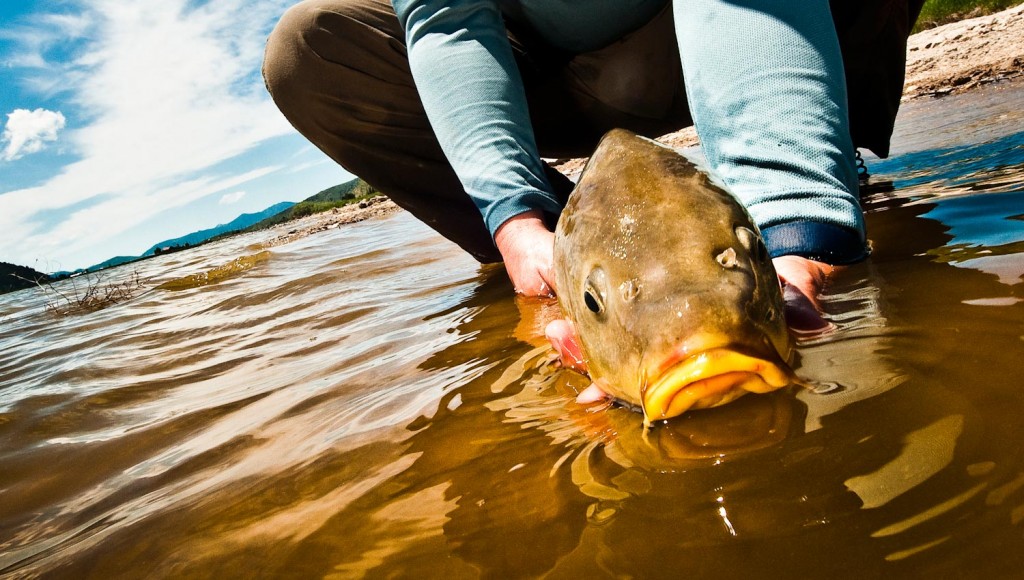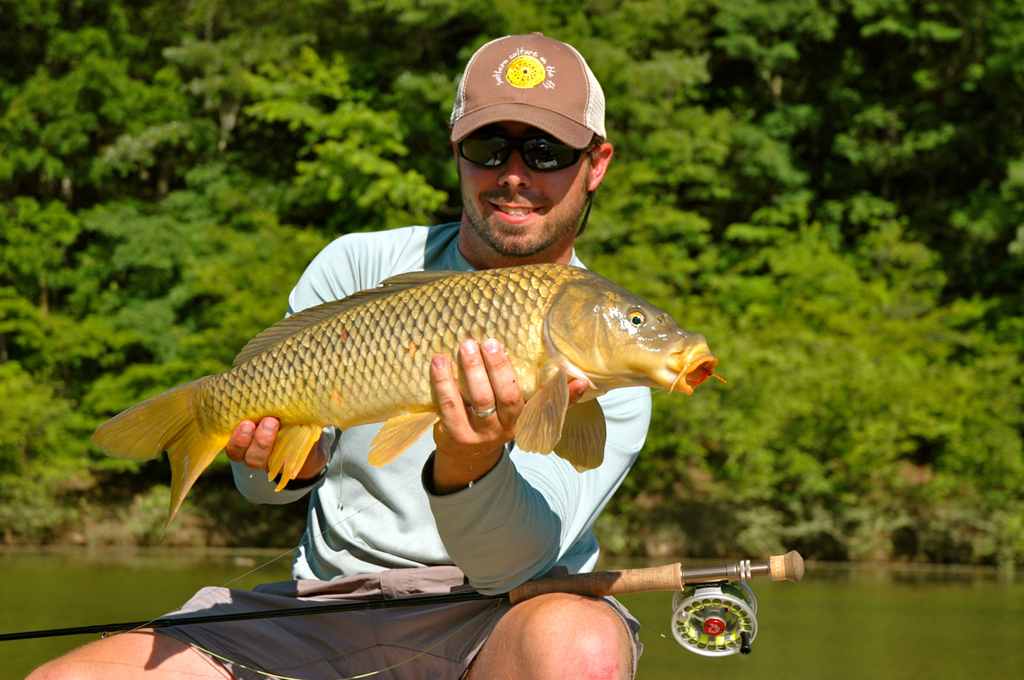Good friend and fly fishing guide, Ryan Dunne has been capitalizing on the growing carp buzz by fly anglers lately.
Ryan commented, “I’ve seen a significant increase in carp fishing inquiries the last two years, and when the dog days of summer arrive and the trout fishing bite goes south, I now opt for poling my skiff and guiding my clients to carp on my local rivers and lakes”. Thank you Ryan for taking the time to sit down with Gink & Gasoline to answer twelve frequently asked questions about fly fishing for carp.
Have you found certain colors of fly patterns to be more effective than others?
I find that the water conditions and ambient light conditions dictate which color is more effective. I typically stick to four different colors when tying carp flies. They are black, brown, olive, and orange. Although the majority of my flies are tied in the aforementioned colors, I do tie with other colors as well.
Have you found certain fly tying materials (synthetics or natural) that carp seem to dislike?
I haven’t noticed a difference in carp behavior towards either type of material. However, most of my fly patterns contain a combination of both synthetic and natural fly tying materials.
What are a couple of your favorite go-to carp flies?
My two favorite patterns are the Carp Carrot and Carp Dragon.
Is the weight of your fly patterns critical and if yes, when do you prefer heavier flies?
Weight is definitely a key part to my subsurface carp patterns. Feeding carp rarely stay in one place, so you want to get your fly in the feeding zone as quick as possible. Water depth will dictate the weight of my patterns. I find that bead-chain and dumbbell eyes in various sizes are ideal for carp patterns.
When would you say is the most consistent time to go carp fishing?
I would have to say June through October are your most consistent carp months of the year.
Do you find carp fishing easier or harder on the lakes or rivers? Do you have a preference.
I find that carp fishing is pretty much the same on both lakes and rivers. Most of my carp fishing experience are on river systems with a series of lakes and dams. I really don’t have a preference for one over the other.
What’s your favorite fly rod and reel setup for carp fishing?
I have two favorite rod and reel setups for carp. The first is a Sage One, 6wt with a fighting butt and Nautilus FWX reel spooled with a Rio Carp WF6 fly line. The second is a Sage Xi2, with a fighting butt and a Lampson Velocity reel spooled with a Rio Smallmouth WF7 fly line.
Are you matching the hatch with your carp fly patterns, or do you prefer fishing impressionistic patterns that imitate multiple food sources?
I tend to fish impressionistic fly patterns that have the ability to resemble multiple food sources. While there are times when matching the hatch is important, I find that the common carp is not that picky when it comes to fly patterns. Fly presentation is often more important than pattern choice for catching carp. Because the Commom Carp is an omnivore, it has a very diverse diet, and that naturally opens the door for them to feed on a multitude of things. I focus on making sure my fly patterns are tied with materials that do a good job of mimicking the key characteristics and movements that carp regularly see in their food sources.
Generally what is the best time of day to catch carp?
On my home waters, carp will feed all day. That being said, they’re not always at water depths or in locations where you can always see them. During early spring and late fall, I often locate and find carp feeding in the shallows during the heat of the day. During the summer months carp spend much more time during the day in the shallows feeding. Except during extreme heat waves, carp fishing is
Can you talk about carp fishing scenarios a bit, primarily on how to present the fly to carp in different situations?
Carp have to be one of the hardest freshwater gamefish to present a fly to. When I’m fly fishing for carp, I concentrate my time and effort searching for fish that are tailing (mudding) or slow cruising. Mudding carp are basically rooting around the bottom in search of food. This usually has them inverted, and if the water is shallow enough, they’ll often have their tail exposed out of the water, much like redfish and bonefish do. When I’m presenting my fly to a mudding carp, I’m aiming for a target about the size of a dinner plate as close to the carps head as possible, making sure I don’t hit or line the fish. The reason I like to place my fly so close to carp mudding is because they’ll generally create a thick cloud of sediment and debris around them, and the closer you get your fly to the fish the better the chance the carp will see your offering.
Carp that are sauntering along and slow cruising, will usually stop here and there to opportunistically feed, whether it’s a mulberry that’s freshly fallen from a tree, a crayfish, or a floating piece of plant matter. I typically try to place my fly two feet or less in the path of the carp in this situation. If you spot a carp that’s moving at a faster pace than normal, like it’s late for something, you’re usually better off passing and not casting to the fish. Casting to the wrong carp and spooking it, can shut a piece of water down. This happens because a carp that feels threatened will often emit a pheromone into the water alerting other carp there’s danger in the area, and that can discourage all fish from feeding.
What’s the most common mistake you see your clients make carp fishing when you’re guiding?
The most common mistake I notice is anglers are not detecting an eat. Carp suck their food up and that often makes the take very subtle and hard to detect. I pay close attention to a carps body language when I’m trying to detect an eat. If there’s good visibility, the perfect situation is when you can actually see the carp pucker its lips when it eats, but this isn’t always the case. If I can’t see the fly, I try to watch for the carp to move over to the fly and stop. When it stops I’ll slowly strip the fly very slowly. If the carp eats the fly, you’ll generally begin feeling a slight resistance, and that’s when I’ll give a firm strip set. If you’re fishing a floating fly, the eat is generally a no-brainer. Carp feeding on the surface will usually have their entire head out of the water when they eat the fly.
On a good day how many shots can you expect to get carp fishing, and if perfect presentations are all you make, how many eats?
On a good day you can expect around 25 or more shots at carp. Now when I say shots, I mean shots at potential eaters. It’s hard to put a number on how many eats you might receive because there’s so many factors that go into carp fishing. I will say this though, if you make good presentations and the fish are feeding, you can expect to catch carp.
For more information on Ryan Dunne and his fly fishing guide service, please visit Appalachian Fly Guides.
Keep it Reel,
Kent Klewein Gink & Gasoline www.ginkandgasoline.com hookups@ginkandgasoline.com Sign Up For Our Weekly Newsletter!


Sorry, this is not really about carp fishing…
But I was wondering, being that you are in the photography industry, what is the best sort of camera for filming short clips? I have documented my trips for years with photos, but now I am looking to try to make some sort of montage (like MontanaWildOutdoors or Catch Magazine), and I need a new camera. Am I better off going with a camcorder?
Thanks, Troy
Pingback: Tippets: Casting for Carp, Reversing Course on Beavers | MidCurrent
Check out Eric Corya from Indianapolis. He has landed 1000’s of carp on the fly. Twitter, @Carpstalker. He is an amazing angler, tying artist and guide.